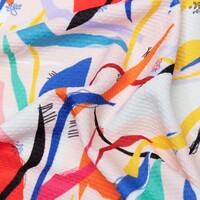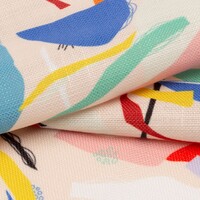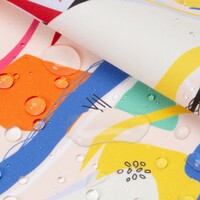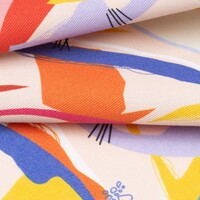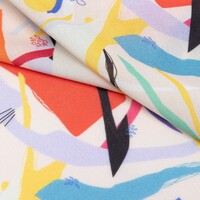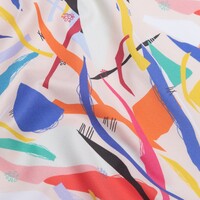Related:
Back to Site Stores ({{popupVm.storeTotalCount}})
Artists ({{popupVm.artistTotalCount}})
Customize your own design and have it printed on breathable fabric. Breathable material is perfect for hot...
Read MoreShips in 1 - 2 days
US Shipping $9.95
Everything made to order
Order breathable fabric by the yard, meter or even in centimeters or inches with your personalized design printed in full color.
Browse our range of breathable fabrics.
Medium weight, stiff and non-stretch with a matte finish
100% polyester
Medium weight, soft and stretchy with a matte finish
96% polyester 4% elastane
Medium weight, soft and stretchy with a matte finish
100% polyester
Heavy weight, soft and stretchy with a matte finish
97% polyester 3% elastane
Medium weight, stiff and non-stretch with a matte finish
100% polyester
Light weight, soft and stretchy with a matte finish
90% polyester 10% elastane
Medium weight, smooth and non-stretch with a matte finish
100% polyester
Light weight, smooth and taut with a matte finish
100% Silk Reactive inks
Expected Shrinkage = Weft: 6% Warp: 9%
Lightweight, stiff and non-stretch with a matte finish
100% polyester
Heavy weight, soft and non-stretch with a matte finish
100% recycled polyester
Medium weight, soft and non-stretch with a matte finish
100% cotton
Medium weight, coarse and stretchy with a matte finish
95% polyester 5% elastane
Medium weight, soft and stretchy with a smooth finish.
96% polyester 4% elastane
Medium weight, soft and stretchy. Eyelet knit gives honeycomb surface effect,
100% polyester
Lightweight, quick-dry and stretchy with a pinhole finish
100% polyester
Heavyweight, stiff and with a matte finish
100% polyester
70% wool, 30% silk. Woven in Italy and finished in England. Light cream base color, open plain weave. An airy, light, flowing, soft yet strong quality, Suitable for scarves and fashion. Expect shrinkage 4% weft, 2% warp. Super bright colors and deep blacks using reactive ink chemistry.
70% wool 30% silk
Expected Shrinkage = Weft: 5% Warp: 3.5%
100% pure Silk. 0.6" or 1.77 oz. Off white base color with a sparkle. Soft lightweight fine quality, with a crepe finish and light ribs in the weft. Airy, light, flowing, soft yet strong. Straddling the border between fashion and fashion accessories. Expect shrinkage 5% weft, 8% warp.
100% silk
Expected Shrinkage = Weft: 5% Warp: 9%
70% cotton 30% silk lightweight woven voile. Print shows through 90% to reverse. Super bright colors & deep blacks using reactive ink chemistry.
70% cotton, 30% silk
Expected Shrinkage = Weft: 2% Warp: 1%
Floaty and buttery soft fabric with an elegant drape. Plain woven lightweight 100% viscose with slight stretch in the weft. Super bright colors & deep blacks when layered. Printed using reactive ink chemistry.
100% viscose
Expected Shrinkage = Weft: 5% Warp: 1%
Soft, elastic, matte, opaque, knitted, recycled Poly Jersey. Soft touch Jersey. Use: clothing, t-shirts. Polyester yarn made from 100% post-consumer waste.
96% Recycled Polyester, 4% Elastane
325 thread count, high quality bedding material. 100% BCI cotton (Better Cotton Initiative) . Bright white base color, smooth luxury delicate yet durable material. 5-Star hotel bed linen quality. Wide width material at up to 68.9" print width.
100% cotton Pigment Inks
Expected Shrinkage = Weft: 1% Warp: 1%
Medium weight 100% linen plain weave fabric. Contains characteristic slubs and bobbles, will include occasional unprinted white dots. Super bright colors & deep blacks using reactive ink chemistry. Uses: clothing, kitchen textiles, curtains, light upholstery.
100% Linen
Expected Shrinkage = Weft: 5.8% Warp: 1.6%
Lightweight bright white cotton, with crisscross texture. Sharp and defined pigment print with bright colors and deep blacks, working well with the classic slub texture. Uses: Garments like shirts, dresses, light jackets, and homeware items such as tablecloths, napkins, tea towels, bedding.
100% Cotton
Care instructions
Wash at 86°F, low tumble dry heat, hang to dry, do not wring, low heat iron.




Breathable fabric is a material which has the ability to allow moisture vapor to be passed through it. This makes for great all-weather garments, and are among the best fabrics for sweating. There are two ways in which moisture can pass through a fabric. The most common is ventilation; this is where the fabric itself is porous, which allows the air to pass through - or vent - from it. If there are bigger and more holes (or pores) the textile will be more breathable than those with fewer or smaller pores. There are some non-porous fabrics which can be breathable materials, this type of material is often breathable waterproof fabric.
For a fabric to be noticeably breathable, there must be a difference in the air humidity on either side of the fabric; and water can move both directions through a textile. If - for example - you've been for a run, and it is 68% humidity inside your breathable shirt, but the humidity outside is only 25% because it is a warm, sunny day, then the water vapor inside your shirt will naturally want to pass through your breathable material to the outside. If the air humidity is 40% on both the inside and the outside of your shirt, it will still be breathable, however you wont notice it. If the air humidity on the outside of your shirt, is higher than that inside, then the water vapor will actually move inwards. This is not common, and is more likely to be seen in places that are near coastal regions and close to the equator.
You have four edging options for your printed breathable fabric:
"As is" - we will send your fabric exactly as it comes from the digital printer, with an unprinted border around the edge of your design.
"Cut on The Line" - have one of our experts cut your print out, leaving no white edges on your breathable material
Hemmed - with a choice of an overlocked hem, or a baby hem. To create a hem on light weight material or medium weight fabrics that fray, we will make a two fold hem using a straight stitch. On heavy, stiff or no-fray fabrics, a single fold hem with a straight stitch is used.
Please ensure that you take the hem into account when selecting your custom sizes. For light fabrics the hem will take up 0.23" - 0.31", on each of the 4 sides. On other fabrics the hem will take up 0.59" - 0.78", on each of the 4 sides.You can choose either black or white thread for either of the hemming options.
There is more than one way to print on breathable materials - including dye sublimation and pigment printing. All of our expert methods will permanently bond your design to your chosen custom fabric, in full color. Pigment printing is mostly used in natural fabrics; it is a very localized printing method, which applies colored dyes directly to a part of the fabric, and builds up the design. Dye sublimation is a two step process, more frequently used with synthetic materials. It involves printing your design onto a transfer sheet, and then using heat to permanently bond this to your printable, breathable fabric.
We print at 200dpi, which is a good combination of quality and file weight. Ideally, your image should be scaled to 100% at 200dpi; this means that no resizing of your file occurs, preventing any interpolation. Our design interface will have a quality marker next to the design that you have uploaded, this will change color using a traffic light system and display a message. The message will let you know if the resolution is too low or if you have a good quality image.
When you upload your design our system will automatically scale it to fit your chosen fabric dimensions. In the ‘Product Image’ tab, the displayed dimensions under ‘Print Size’ will show the dimensions of the piece of fabric that you are ordering. For image/design dimensions you need to see the ‘Images & Text Tools’ tab. You can see and edit the dimensions of the image under the quality information next to the thumbnail.
We advise providing images in the RGB color space. Specifically using the sRGB image profile, to achieve best color results. What does this mean? In your editing software, choose RGB as the working space and assign the image profile as sRGB (full name sRGB IEC61966-2.1)
For most of our fabrics, there is no limit on the length of the fabric that you can order. We have a preview design window set up to 10 yds max to visualize the print, but that's not a print limit. If you'd like to order more, increase the quantity (x2 for 20 yds or x4 for 40 yds for e.g.) and then you can order as much as you'd like, with a built in automatic volume discount too. The maximum print width of each fabric can be found on the individual fabric pages or in our design interface.
Yes, that might help you! Always incorporate any extra space or borders into your purchased fabric size. We trim squarely around fabric samples and fabric prints, leaving approximately 0.2" white space. Cutting neatly on the line has an additional fee.
Crocking, which is fading along the creases, often after washing or heavy use, occurs when you digitally print on natural fabrics - more so when dark or dense colors are used. It can be minimized by using a cool hand wash instead of machine washing as the tumbling of the machine is the main cause of this. To avoid entirely, we would advise using a poly fabric.
Our organic fabrics do not have any coatings that the non-organic fabrics have. This means the ink absorbs into the fibers, reducing the color strength slightly (by approx. -40%). For super-strong colors, we recommend a non-organic natural fabric.
Unfortunately not; we like to test meticulously so that we know what gets the best results on our fabrics, and our facilities cater perfectly to them. We do however print sublimation transfer paper to order, and if you have access to a heat press you can press your own fabrics easily.
For multi-colored or very detailed files we recommend using a tiff format, but they must be flattened. For simple colors and low detail files, a jpeg is fine.
Just like many fabric printing processes, there is the potential for shrinkage. Depending on the fabric, please expect and allow between 2-8% shrinkage which you need to plan for in your dimensions. This percentage can vary from print run to print run and between fabrics, so we would advise to order a little more material than you require for your project.
We do not offer to print on both sides of the fabric, as a lot of our fabrics are semi-transparent or have some show through. This wouldn't work with double-sided printing. This is not a service that we offer on any of our fabrics.
At the moment no, our labels are all printed on the same satin fabric. We may introduce more in the future, but for now, this is the best choice. The labels are all cut the same way. You can order the fabric of your choice and make the labels yourself, but we do not cut different fabrics into label format.
With environmental consciousness in mind, our fabrics are all printed using completely water-based inks. This means no chemicals or solvents are used. Our heat fixing procedure fixes the colors and prints, avoiding the downsides of steaming, such as excess or contaminated water returning into the waste system. We have one facility where we conduct all the printing, production and fulfillment. Rather than roll the fabrics, or send them in a tube, we fold them before they are sent out to you. This saves over 150 tubes a week, as well as a lot of space on the delivery van. (For delicate fabrics we ensure to package appropriately).
We work at improving our color profiles all the time. Though rare, it may happen that from one print run to another, and there could be slight color differences, this is normal and part of the process when we are constantly improving. It is extremely unlikely that there will be a huge difference (like orange instead of red for example). Please bear in mind such color variations can be intensified from fabric to fabric due to the varying grains and textures of the fabric. This is due to the construction of the materials as well as the print methods that have to be altered slightly for more delicate, natural textiles.
We have a full Cut & Sew service here at Bags of Love, and are able to hem your fabric prints for a small additional charge. We create a small one- or two-fold hem that typically uses 0.2" to 0.75" (5-20mm) of material, depending on the thickness of the fabric. So, for example, if you want a finished piece of fabric that measures 39.37" x 39.37", you will need to order a size of 39.96" x 39.96" to allow for the hem (on top of that please also allow for shrinkage of min 2%). The thicker the fabric, the bigger the hem will be. You can choose to have your prints hemmed with either Black or White thread. On our silk and other light woven fabrics, one hemmed edge will be straight (vertically down the roll) and the other will be slightly rippled. The hemming material allowances are as follows and you need to make your print bigger to accommodate the hem:
All of our fabrics are cut manually by hand, with the utmost care and attention. If your fabric has a slightly uneven look on the edges or a touch of fraying, this does not indicate a flaw in the textile. It is not always possible to achieve a perfectly straight cut with certain fabrics, so please do bear this in mind when it comes to your design. If you have any queries or would like to know about our cutting methods in more detail, please get in touch and we will be more than happy to discuss them with you.
For further information about our fabrics see our FAQs.
Please note: As everything we provide is handmade to order, you may find a slight variance in the sizes.



